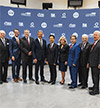Critical Site Selection Factor #9: State and Local Incentives
States are highly competitive with each other for investments and jobs and therefore offer incentives that can help offset project and operating costs and make a significant impact in the final decision.
Q4 2016
States want to make the winning offer that maximizes project-cost feasibility and reduces operating costs through incentive packages customized to the potential client’s needs. This is also becoming increasingly important for keeping existing companies within their borders; these companies increasingly shop themselves around and dangle their job numbers in front of economic development teams in other states — moving isn’t such a big deal anymore, especially if they can get a great incentives package.
Incentives that states and communities offer include land acquisition, infrastructure construction or improvement, low-interest financing, tax credits, and expedited permitting. Sometimes low-cost energy is part of the deal, including rate discounts, tax exemptions, and grants for utility infrastructure improvements.
Companies are most attracted to cash-equivalent incentive programs that help offset operating costs, such as cash-refundable job-creation tax credits, property tax abatements or refunds, training grant dollars, and infrastructure grant dollars. Examples of cash-equivalent incentives that lower project costs include deal-closing funds to purchase land, tax increment financing (TIF) funds to offset construction costs, and grant dollars to purchase equipment.
An increasingly popular (and creative) incentive that states are using to attract economic development is training partnerships to help companies close the skills gap. Addressing the Skills Gap
An increasingly popular (and creative) incentive that states are using to attract economic development is training partnerships to help companies close the skills gap.
“The shortage of qualified applicants to fill open positions remains a primary concern with many of our clients, especially in manufacturing,” states Eric Stavriotis, senior vice president in the CBRE’s Chicago Occupier Practice Group. “With the rise of advanced manufacturing and new automation techniques, production jobs are increasingly technical and specialized. Skills are less transferrable between industries and employers. The general labor pool may have a breadth of skills and experience, but too often lacks the exact mix that is required for these specialized roles.”
To combat the skills gap, more companies are leaning heavily on internal training curricula and career path programs, cultivating talent from within. This ensures that all employees receive the exact training they need, and that employers have direct control over the way proprietary procedures and processes are taught.
This approach has interesting implications for site selection, notes Stavriotis. In the past, expanding companies would pore over sophisticated labor studies, chasing markets that seemed to promise the perfect talent mix. Today, many are looking inward, focusing instead on crafting the internal training curriculum necessary to build a strong talent pipeline, regardless of where they land — and increasingly are looking to state development agencies to assist, screen, and even train their workers, often at no cost.
“As these companies relocate or expand into new markets, local training partnerships are essential,” says Stavriotis. “Often markets that offer the strongest training assistance lead the short list — and local educational institutions and networks can be as important as labor costs and tax rates.”
Specifically, when seeking a good training partner, companies look for confidentiality of proprietary curricula, flexibility of curriculum and requirements, simplicity of administrative functions, transparency of funding dispersal, versatility of industries and occupations, immediacy of funding, and diversity of training resources.
Sealing the Deal
Although incentives can add up into an attractive package, they can be a bit distracting from fully evaluating other key site selection factors. Most site consultants agree that incentives shouldn’t be considered until there is a short list of three to five final potential locations. At this point these locations all look very similar in terms of key factors such as human capital, tax liability, real estate, infrastructure — it is at this juncture that incentives can help offset project and operating costs and make a significant impact in the final decision.
Project Announcements
Momentous Expands Summit County, Utah, Operations
12/21/2025
Stryker Expands Salt Lake County, Utah, Operations
12/21/2025
Portal Space Systems Expands Bothell, Washington, Operations
12/21/2025
TerraForge Biocarbon Solutions Plans Magnolia, Mississippi, Operations
12/20/2025
Coastal Ready Mix Plans Conway, South Carolina, Production Operations
12/20/2025
PRET Advanced Materials Expands Johnsonville, South Carolina, Manufacturing Operations
12/19/2025
Most Read
-
The Workforce Bottleneck in America’s Manufacturing Revival
Q4 2025
-
Rethinking Local Governments Through Consolidation and Choice
Q3 2025
-
Lead with Facts, Land the Deal
Q3 2025
-
Investors Seek Shelter in Food-Focused Real Estate
Q3 2025
-
Tariff Shockwaves Hit the Industrial Sector
Q4 2025
-
America’s Aerospace Reboot
Q3 2025
-
The Permit Puzzle and the Path to Groundbreaking
Q3 2025



